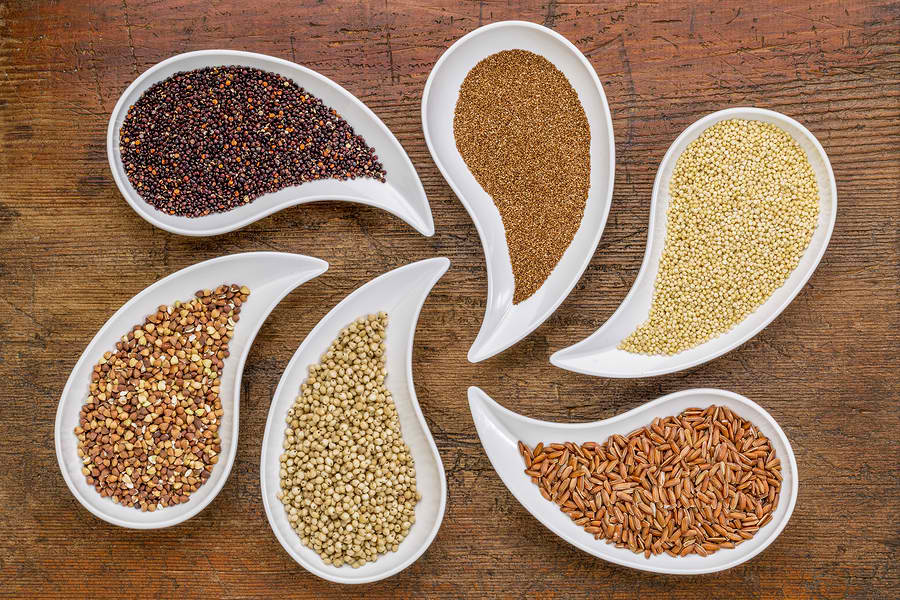
This post may contain affiliate links. We are compensated for referring customers to our affiliate partners.
You see the word “grain-free” on dog food labels all the time, but is it really better to feed your dog grain-free food? Dogs are carnivores, but they can get balanced nutrition from an omnivore diet. So when choosing a dog food, it’s hard to know if a grain-free dog food is really the best option.
We’ve put together a pros and cons list to grain-free diets, in order to help determine if grain-free dog foods are actually better for the health of your dog.
What Is The Difference Between Grain-Free And Regular Dog Food?
Before we get into the pros and cons it is important to understand the difference between grain-free and regular dog food. Grain-free dog food does not contain any grains in the ingredients. Grains include wheat, rice, oats, and even corn.
Regular dog food usually contains grains in the ingredients. Some natural and organic dog foods contain whole grains which are grains that are unprocessed so they maintain the full nutritional profile of the grain. Whole grains tend to be viewed as healthier because they are not degraded by processing. The best way to determine if a dog food is grain-free, contains grain, or uses whole grain is by reading the ingredients label.
Pros Of Regular Dog Food
A big pro of regular dog food is the cost and availability. Grain-free dog foods usually cost more and are not always available at your neighborhood grocery store. Regular dog foods also contain more complex carbohydrates that help give dogs energy. So they can better than grain-free dog foods for older dogs and dogs that are less active. They also contain a lot of fiber which helps keep dogs regular and can help them lose weight. Also, grains provide a lot of protein and some veterinarians recommend dogs get protein from multiple sources beyond just meat. Dog food that contains grain will also have more “filler ingredients” which help your dog to feel more full after a meal. Finally regular dog food has more variety of ingredients so the nutritional profile may be more complete than a grain-free dog food.
Cons Of Regular Dog Food
The biggest con of regular dog food is there may be some health risks associated with eating grains for certain dogs. Like people, dogs can have grain allergies or gluten intolerance, while some have digestive troubles. In cases with these dogs, a regular dog food can aggravate these sensitivities and cause a myriad of health problems. Also some regular dog foods use grains as filler because they are cheaper than meat. In the case of fillers, grains add nothing to nutritional profile of the food and will not be the best option for your dog. Finally, regular dog food is not the best option for nursing or pregnant dogs because they need very high protein levels for both themselves and their puppies.
Pros Of Grain-Free Dog Food
The biggest pro to grain-free dog food is the high protein content. Grain-free foods usually contain more meat which is very high in protein and necessary for the health of your dog. A high meat-based protein diet is great for active dogs because it helps give them sustained energy and keeps them fit. Grain-free dog foods also tend to have better quality ingredients because they contain no fillers like corn meal or wheat gluten. These fillers provide no nutritional value. Also, grain-free diets are great for some dogs to help them maintain a healthy weight. They are especially good for diabetic dogs because they contain less simple carbohydrates that can cause an unhealthy spike in blood sugar.
Cons Of Grain-Free Dog Food
The biggest con to grain-free dog food is it may not provide a balanced nutritional profile. Grains contain a lot of nutrition from omega 3 fatty acids to potassium and magnesium to vitamin B6 and B12. In grain-free dog foods, manufacturers often use carbohydrates that provide less nutritional value than grains and substitute filler ingredients like corn with plant based fillers such as peas. They may also use carbohydrate sources with high starches that can cause weight gain. Also grain-free does not mean that the meat sources are trustworthy, grain free foods can also use animal by-products that are not necessarily healthier than grains. Finally, grain-free dog foods can also be more expensive than regular dog foods, so if they are not providing the full nutritional range your dog needs the extra expense is a waste of money.
The Nutritional Content Is What Really Matters
The are pros and cons to both grain-free and regular dog foods. Grain-free may be a great options for your dog, but it may not be the best option. The best option is to go with the dog food brand that has the best nutritional content for the specific needs of your dog. You can work with your veterinarian to determine which is the healthiest dog food for your dog. Your vet will make specific nutritional recommendations based on the health, lifestyle, and age of your dog and from there, you will know whether to buy grain-free or regular dog food.
Regardless if you and your vet have decided you will go grain-free or stick to a regular dog food, you need to then make sure you always read the nutrition label. The label will tell you all the ingredients so you can avoid fillers or bad carbohydrates. It can help you figure out if the vitamins and mineral content is good for your dog and also if the manufacturer is using high-quality ingredients. So whether you decide to go grain-free or not, if you keep your dog’s nutritional needs in mind, you will always pick the healthiest dog food.
